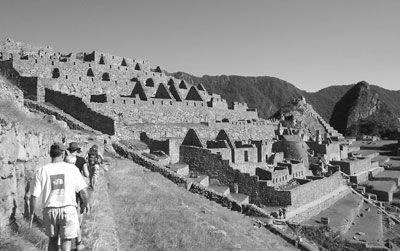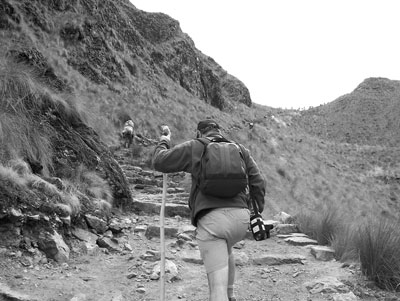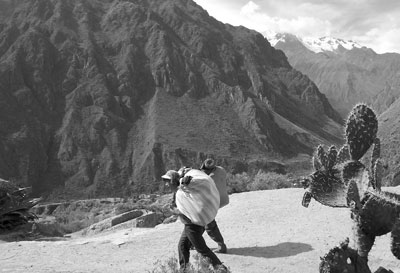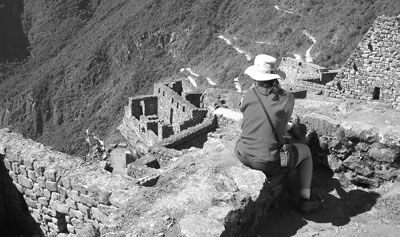The life of a Peruvian porter
by Tim Leffel, Nashville, TN
Climbing up the steepest parts of the Inca Trail in Peru, I hear only singing birds, the panting of our fellow hikers and the rhythmic clicks of walking sticks striking the old stone steps. The sound of rapid flip-flop footsteps forms faintly in the distance and gets steadily louder. “Porters!” someone shouts, and we all shuffle to the side of the trail to let the loaded-down carriers pass.
We each are carrying only a small daypack filled with what we need during the day. The porters each have 55 pounds of food or camping gear strapped to their backs. They still move faster than we do.
I have gone on a few hiking tours over the years, but this time I wanted to find out what the life of a porter is really like. What makes them want to take on this job? Do they really make any money? What do they think of these pampered tourists who fly in from around the world to go camping in the mountains?
Appearances can be deceiving
A few days before the hike, I needed to visit our tour operator to settle up on fees. I walked along the busy cobblestone streets of Cuzco and through the historic Plaza de Armas, flanked by two imposing cathedrals and rows of carved wooden balconies perched over stone arches.
It was getting dark as I ducked through the small portal cut out of a massive, thick wooden door and stepped into a large courtyard. As my eyes adjusted, I saw a long line of local men on the balcony outside the trekking company’s office. I had arrived on porter payday. The 40 or so men waiting to get paid looked surprisingly small and wiry.
Once we started the trek, however, it was obvious who was stronger. As soon as our group started the ascent, porters bounded past us with huge loads on their backs, some carrying full tanks of propane, while we struggled to get up the trail carrying almost nothing.
By the time we got to camp the first night, our tents were already set up and the smells of corn soup and fried trout wafted from the cooking tent. Soon after we changed into warmer clothes, dinner was served in the dining tent, complete with tables and stools that would be carried along for four days.
Hiking the Inca Trail
The Inca Trail is likely the most popular multiday hike in the world. The daily departure limit is restricted to “only” 200 tourists and 300 porters, yet the permits often sell out months in advance.
When I was hiking in late June ’05 it was high season, so all permits had been taken. Still, it rarely seemed crowded except at a couple of the camps at night. These camps are graded and equipped with permanent toilets, however, helping the environment recover from years of free-for-all conditions.
Hikers spend four days and three nights soaking up Andean mountain vistas and seeing ruins that can be visited only on foot. The prize is arriving at the spectacular site of Machu Picchu just before sunrise.
On the morning following our first night of camping, the porters all introduced themselves before we set off for the day, each giving us their name, hometown and age. Our guide explained what individuals’ names meant in Quechua, the local language, which was also used by the Incas.
“Looks like he’s 50,” muttered the woman next to me after a 31-year-old porter spoke. Many of the porters are also landowners who farm crops or raise animals near small valley towns such as Ollantaytambo and Chinchero. Years of sun and mountain winds take their toll.
Bucking the image of the stoic manual laborer, the porters seemed to smile continuously during our 4-day trip.
“It is hard work, but they can joke with their friends, have a good time and take a break from their wives,” explained our guide, Oscar.
A living wage
Working as a porter can mean the difference between barely eking out an existence on the land and having a relatively comfortable life.
“I raise wheat, peas, beans, quinoa and animals, so we have plenty to eat,” explained porter Eranjelio Seina Castca, who lives in a stone-and-mud-brick house near Pisac, an Incan fortress. “This money lets me fix up my house and buy books and clothes for my children.”
With five children spanning the ages of four to 19, it made sense that he was still at it after 600 trips on the circuit.
Various porter-welfare groups have lobbied for better standards for these men and have tried to coax tour companies into paying each one a wage of at least 100 soles for the 4-day trek. At that rate, counting tips, if a porter goes out five times per month, he will make about $150 — equivalent to the retail price of the backpack I’d bought before leaving home.
In the villages scattered around the Sacred Valley between Cuzco and Machu Picchu, however, the better-paid porters and cooks are actually considered middle class compared to many of their neighbors.
When Peru Treks & Adventure started a school supplies donation program in villages where their porters lived, some unforeseen dynamics cropped up.
“As soon as we started delivering supplies to the public schools, we heard grumbling,” explained Mike Weston, founder of the agency. “It turned out that most of the porters were sending their kids to a private school on the edge of town. They wanted the supplies to go there, where their kids were, not to the public school. It was a messy situation that I never expected.”
Plight of the porters
Anyone can rent an office in Cuzco for a hundred bucks, throw up a sign and call themselves a trekking company. Many of them simply pocket a commission and then channel clients into a central pool.
“If you are paying less than $275 to hike the trail, it’s a certainty that the porters are not being treated well,” says Ann Noon, a journalist who worked with the Inka Porter Project for several years. “The easiest and least visible place to cut corners is in the pay and treatment of the porters.”
A high price doesn’t necessarily equate to better treatment either. “The worst exploitation comes from some of the highest-priced agencies,” explained Weston. “A lot of times the actual trip is run by a local operator who is doing everything on the cheap.”
In the years before government regulations and market pressures kicked in, poor porter treatment was standard practice. Some travelers wistfully recall the era when they could just show up and hike the Inca Trail for next to nothing. When I spoke to Castca, he felt no nostalgia for that period.
“There was a lot of misery before the controls started,” he explained. “We would have to carry over 50 kilos (110 pounds) and there was never enough food. We had to sleep out in the open, with no tents. If it rained, we would try to find a cave so we could stay dry.”
Other longtime porters talked of huddling together at night to compensate for the lack of blankets and of carrying trash bags with them to have something to lay over the mud for sleeping.
“A lot of porters became alcoholics,” added Castca. “They would drink to stay warm and to help them sleep in the cold. After a while it was a habit.”
A special place
As I sat with porters Castca and Angel Flores Bañares in the dining tent on the last night, under the glow of camp lanterns, I asked them what they thought about us travelers. Did they think we were nuts to pay hundreds of dollars to sleep in tents and hike among mountains they see every day?
Bañares furrowed his brow, adjusted his alpaca hat and answered slowly, “We don’t think you are crazy at all. You have dreamed of coming here and seeing these mountains and learning the history of the Inca culture. You live in a big city and don’t have views like this, so you want to come spend some time in this special place.”
“And you get bored with all the technology and the noise and you want to escape,” added Castca. “You can dream about the Incas and see photos of Machu Picchu, but you can only feel our history by walking in these mountains and seeing the Andean people.”
As they talked, a few other hikers playing cards at the other end of the table stopped what they were doing, looked up and nodded with a smile.
Sometimes the eyes of a porter see far more than we expect.
Arranging a trip
If you book a tour from home, the Inca Trail is usually included as part of a larger package. If you book the 4-day hike independently through an agency in Cuzco, expect to pay $300 to $360 per person. This includes meals, permits, the entrance fee to Machu Picchu, a personal porter and a basic train ticket from Machu Picchu back to Cuzco.
Mid-range lodging in the Cuzco region runs $25-$70 per night for two, usually including breakfast. Rooms at the 4-star level are generally $75-$150. Book ahead during high season (May through September).
Andean Travel Web (www.andeantravelweb.com) is the best resource for finding a reputable tour company, and it also has good lodging reviews.
I used Peru Treks & Adventures (phone 0051 84 505863, www.perutreks. com) for my trek. They have an excellent reputation for taking porter welfare seriously. The 2006 price for the 4-day trek is $340.




